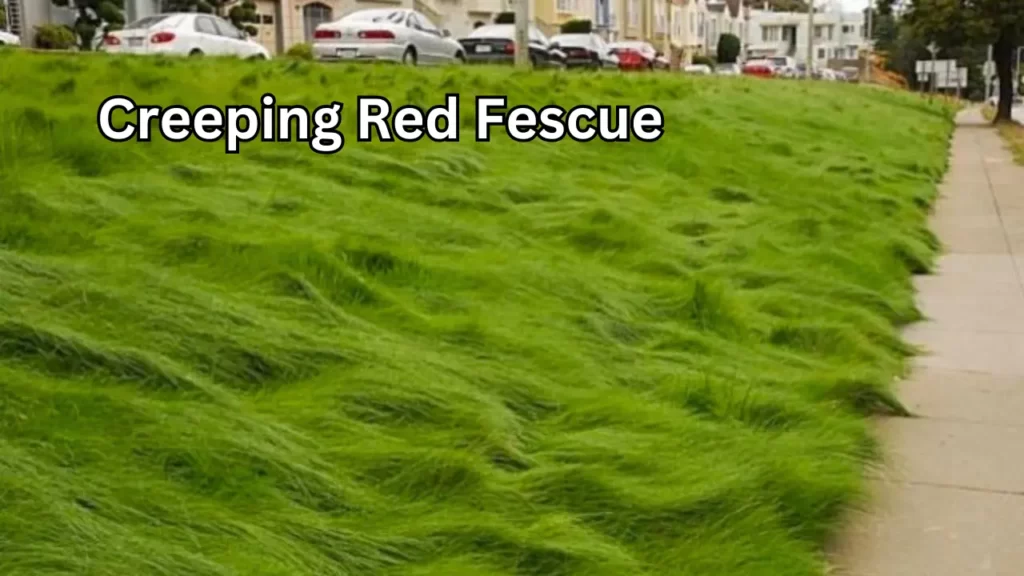To create a vibrant and beautiful appealing lawn it is essential to choose the right grass types to get the required results. There are many grass types available that can create a beautiful lawn. Chewing Fescue and Creeping Red Fescue are two popular grasses that most homeowners choose.
So, here in this article, we will do an in-depth comparison between Chewing Fescue vs Creeping Red Fescue including its features, benefits, climate condition and maintenance, etc. So you can choose the right grass for your lawn from these two best grasses.

Chewing Fescue vs Creeping Red Fescue: Quick Comparision
| Features | Chewing Fescue | Creeping Red Fescue |
|---|---|---|
| Growth Habit | Clumping Growth | Creeping Growth |
| Appearance | Fine Blades | Fine, Narrow Leaves |
| Shade Tolerance | Moderate | Excellent |
| Climate Suitability | Cool and Temperate Climates | Cooler Regions, Maritime Climates |
| Traffic Tolerance | Moderate | Low |
| Drought Resistance | Excellent | Good |
| Soil Adaptability | Adapts to Various Soils | Prefers Well-Drained Soils |
| Maintenance | Low Maintenance | Moderate Maintenance |
| Erosion Control | Not as Effective as Creeping Red Fescue | Effective Erosion Control |
| Aesthetic Appeal | Sophisticated Charm | Natural, Rustic Appeal |
Also Read: Red Fescue vs Tall Fescue Choosing the right one
Chewing Fescue
Chewing fescue (Festuca rubra commutata) is a cool seasoned grass that is popular among homeowners for its fine texture and dense growth. Chewing fescue is a Europe native grass and it got its name from the old practices of chewing the grass to extract its sweet juices, giving a mildly sweet taste, though this is no longer common.
The Chewing Fescue is widely used in golf courses, fairways, parks, and lawns due to its benefits and features.

Features of Chewing Fescue
Appearance
Chewing fescue grasses gives a lush, green appearance, and its fine blades give a smooth and soft texture that adds elegance to any lawn. Also, chewing fescue has a clumping growth habit which helps it to maintain its form and prevent it from excessive spreading.
Adaptability
One of the best features of chewing fescue is its adaptability to various soil types. It can grow in loamy or sandy soils rather than this it can even tolerate moderately saline conditions, making it suitable for coastal regions.
Benefits of Chewing Fescue
Chewing fescue offers several benefits which makes it one of the best grass types for lawns and gardens.
- Drought Tolerance: The chewing fescue is a good resistant to the drought condition and it can even be green in the dry condition with limited water availability.
- Cold Tolerance: The chewing fescue can perform well in the cooler climate also and it can withstand mild frosts (when temperature goes below 0°).
- Low Maintenance: The chewing fescue has a slow growth rate and it does not need more fertilization which makes this grass almost maintenance-free.
Maintenance Requirements for Chewing Fescue
Watering
For healthy optimal growth chewing fescue needs consistent watering. Deep and infrequent watering is recommended for chewing fescue to encourage deep root growth which will help to take water from deep soil in a drought condition.
Fertilization
The chewing fescue growth can be improved with balanced fertilization in the spring and fall, but most commonly chewing fescue does not need much fertilization compared to other grass types.
Mowing
Maintain the chewing fescue at a height of 2-3 inches. The chewing fescue has a slower growth rate so it does not need regular mowing compared to the other grasses.
Also Read: Clumping Fescue vs Tall Fescue Understanding the difference
Best Chewing Fescue Grass seeds
Creeping Red Fescue
Creeping red fescue (Festuca rubra rubra) is also another cool season grass type. As the name suggests the creeping red fescue has creeping rhizomes which allow this grass to spread and create a dense, low-growing turf.
Normally the creeping red fescue is used for lawns, golf course roughs, and erosion control.

Features of Creeping Red Fescue
Appearance
Creeping red fescue has fine, narrow leaves that provide a soft texture. And its deep green color gives a natural charm and beauty to the landscape.
Shade Tolerance
One of the best features of the creeping red fescue is its exceptional shade tolerance. It can even thrive in an area with limited sunlight which makes it suitable grass for the landscape with many trees, buildings, etc where limited sunlight can reach.
Benefits of Creeping Red Fescue
- Shade Adaptation: The creeping fescue can grow in an area with limited sunlight where other grasses may suffer to grow.
- Erosion Control: The spreading growth habit of the creeping red fescue helps in preventing soil erosion on slopes and banks.
Also Read: Kentucky Bluegrass vs Fescue vs Ryegrass: best grass for Lawn
Maintenance Requirements for Creeping Red Fescue
Watering
Creping red fescue needs regular watering and moisture to be in its best condition, especially in the hot and dry season. Unlike the chewing fescue, the creeping red fescue needs regular watering to keep it in lush green condition.
Fertilization
Applying a slow-release, nitrogen-rich fertilizer in spring and fall will promote healthy growth and color. Make sure to take expert advice before using the fertilizer.
Mowing
Maintain creeping red fescue at a height of 1.5 to 2.5 inches to encourage dense growth and discourage weed invasion. Also, these grass types have a fast growth rate so regular mowing will be essential to keep them at a suitable height.
Best Creeping Red Fescue Grass Seeds
Chewing Fescue vs Creeping Red Fescue Choosing Guide
Here are some of the important factors which has to be compared while choosing the grass for your lawn in between Chewing Fescue and Creeping Red Fescue.
- Climate Suitability: The chewing fescue performs best in cool and temperate climates. Whereas the creeping red fescue thrives in the cooler regions and is best suited for maritime climates.
- Traffic Tolerance: The chewing escue can tolerate moderate foot traffic whereas the creeping red fescue is suitable for the area with little foot traffic.
- Drought Resistance: Now both chewing fescue and creeping red fescue can survive in the drought season but chewing fescue performs slightly better than creeping red fescue in drought conditions.
- Shade Tolerance: The creeping fescue can perform better even in a shade making it the best choice for a landscape with more shades whereas chewing fescue needs proper sunlight for optimal growth.
- Aesthetic Appeal: Chewing fescue’s fine texture and velvety appearance lend a sophisticated charm while creeping red fescue’s lush green color creates a natural, rustic appeal.
Which Grass is Best for Your Lawn?
Now both of these grass types have different features which make them suitable for specific lawn types. Now if you have a lawn with shady areas and you need grass that needs less maintenance then the creeping red fescue will be the best choice.
If you are looking for a grass with fine texture which can survive in drought conditions and with the ability to withstand moderate foot traffic then the chewing fescue will be a good choice.
Also Read: Kentucky 31 Tall Fescue vs Bluegrass a quick comparison
FAQs
Can I mix chewing fescue and creeping red fescue in my lawn?
Yes, you can mix both chewing fescue and creeping red fescue in one lawn. The mixed grasses can improve the visual appeal and help to get both grasses benefits.
Is chewing fescue a good choice for a high-traffic lawn?
No, the chewing fescue can handle moderate foot traffic but it may suffer in high traffic.
Will creeping red fescue grow well in a shady area?
Yes, creeping red fescue can grow well in a shady area also.
How often should I water chewing fescue during the hot summer months?
In a hot summer month, it is preferred to water the chewing fescue lawn deeply and infrequently, with approximately 1 to 1.5 inches of water per week.
Can I overseed my existing lawn with creeping red fescue?
Yes, overseeding with creeping red fescue can improve the shade tolerance and overall health of your lawn.
Conclusion
Both chewing fescue and creeping red fescue are the best grasses for lawns but they have different features and benefits which make them suitable for specific lawn conditions. So, make sure to evaluate your lawn condition and pick the right grass types which are suitable for it. Regularly water and maintain the grasses to promote healthy growth.
